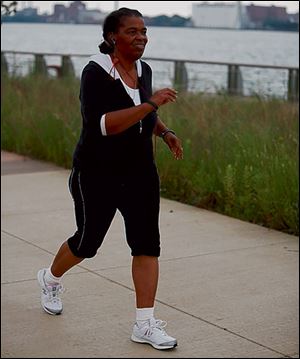
For so many reasons, it’s still wise to walk
9/16/2013
Loretta Moore walks along the Detroit riverfront. Moore lost 62 pounds during a two-year period by walking and changing her eating habits.
There’s a reason so many doctors advise their patients to start walking for fitness.
"It’s easy to do,” says Katherine Velasquez, San Antonio’s physical activity liaison for the Communities Putting Prevention to Work grant. “You don’t need special equipment, although it’s nice to have a good pair of shoes.
“There’s not much of a learning curve. We all know how to walk.”
It’s also suitable for a wide range of fitness levels, ages and weights, and a lot safer than many other forms of exercise.
Research shows that regular walking can help you lose weight, reduce risk of heart disease and breast cancer, boost your mood, ward off diabetes and strengthen your bones. Walking briskly for a total of 150 minutes a week achieves the health benefits of moderate exercise, as recommended by the federal government.
"It’s the most functional form of exercise,” says Shawn Dassie, senior program director for the New Braunfels Family YMCA.
Here’s how to begin:
Get the gear: Make sure you have the right shoes. “Go to a good running store that knows about how to fit people,” says Sara Jacobson, a coach with Houston Fit, a training program for running or walking half and full marathons.
Start slowly: If you’ve been sedentary, begin by walking 10 to 20 minutes, then gradually increase the length of time you walk. Work up to walking at least 30 minutes at a brisk pace (so that you’re breathing more heavily than normal but you’re still able to speak in complete sentences). If you don’t have time to walk 30 minutes at once, break it into three 10-minute walks. Begin with a warm-up and end with a cool-down and stretches.
Stand up straight: Posture is key, says certified marathon walking coach Wendy Bumgardner, the About.com walking guide. Keep your back straight and your head up. Relax your shoulders. Arms should be slightly bent and move in a natural rhythm with your legs.
Join a group: Consider joining a walking program or form your own club to give you support, provide accountability and make it fun, Jacobson says. Or ask co-coworkers to walk with you during lunch or on breaks.
The American Volks-sport Association (www.ava.org) holds noncompetitive outdoor walks across the country.
Record your events in a record book to receive awards, including pins and certificates.
Step it up: To increase the intensity of your workout, try using walking poles, walk uphill or up stairs, or add intervals of faster walking or running, Bumgardner suggests.
Keep it fresh: Vary your outdoor walking routes to keep things interesting. Find routes at www.ava.org and at www.mapmywalk.com.
Indoors, try walking DVDs such as those by Leslie Sansone or Jane Fonda. Videos are available for walking on treadmills.
Set goals: Sign up for 5Ks and other events, even half-marathons and marathons - most are walker-friendly. “It will motivate you,” Jacobson says. “And if you get medals and T-shirts, that’s even better.”